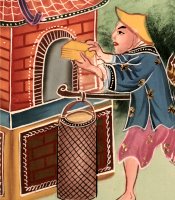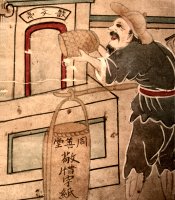 |
As this bibliography makes evident, I am only beginning my study of Chinese hell, and as yet there are very few resources in Chinese and Japanese here. In fact, this list merely reflects the resources in my own possession. I am actually a Han Dynasty historian, and this amateur endeavor into the realm of 19th and 20th century notions of Chinese hell is merely a hobby of mine and not an intensely scholarly venture. |  |
History of death and hell
in
(I include here traditions feeding into
Bokenkamp,
Stephen R. Ancestors and anxiety: Daoism
and the birth of rebirth in
Brook, Timothy, Jerome Bourgon, Gregory Blue. Death by a thousand cuts
Death and Eastern thought: Understanding
death in Eastern religions and philosophies. Edited by
Frederick H. Holck.
Death ritual in late imperial and modern
China. Edited by James L. Watson and Evelyn S. Rawski.
Eberhard, Wolfram. Guilt
and sin in traditional China.
Kominami Ichiro, “From Sutra on Yülanpen
to Mulian-pianwen, the relationship between the recture of Buddhist canon and the storytelling,” Tōhō gakuhō 75 (March 2003): 81-122.
Matsunaga, Daigan and Alicia. The Buddhist concept of hell.
Merh, Kusum P. Yama: The glorious lord of the other world.
Nickerson, Peter
Samuel. Taoism, death, and bureaucracy in
early medieval China. PhD diss.,
Teiser, Stephen F. Reinventing the wheel:
Paintings of rebirth in medieval Buddhist temples.
Teiser, Stephen F. The
ghost festival in medieval China.
Teiser, Stephen F. The
scripture on the Ten Kings and the making of purgatory in medieval Chinese
Buddhism.
Werner, E.T.C. Myths and
legends of
Narratives informing
Chinese hell scrolls
The Mulian story
(Not included here are the numerous surviving Mulian opera texts, many published by Minsu
quyi congshu 民俗曲藝叢書. I hope to translate relevant hell
descriptions for future versions of this website.)
Guo Qitao, Exorcism and money: The symbolic world of the Five-furty spirits in late imperial China. Berkeley, CA: Institute of East Asian studies, 2003.
Guo Qitao, Huizhou Mulian operas: Conveying Confucian ethics with “demons and
gods.” PhD diss.,
Guo Qitao, Ritual opera
and mercantile lineage: The Confucian transformation of popular culture in late
imperial Huizhou.
Judd, Ellen R.
“Ritual opera and the bonds of authority: Transformation and transcendence.” In
Harmony and counterpoint: Ritual music in
Chinese context.
Ling Yiyun 凌翼雲. Mulian xi yu Fo
jiao 目連戲與佛教.
Ritual opera; operatic ritual: “Mu-lien
rescues his mother” in Chinese popular culture. Edited by
David Johnson.
"Transformation
text on Mahamaudgalyayana [a.k.a. Mulian
or Mulien] rescuing his mother from the underworld,
one scroll, with preface." Translated by Victor H. Mair. In The
The Taizong story
Ballads and stories from Tun-huang. Translated by
Arthur Waley.
Journey through the underworld: 10 courts of
hell. Translated by Feng Ge.
The journey to the west, vol. 1. Translated by Anthony C. Yu.
The Qin Gui story
Mote, F.W. Imperial
The Dizang story
Bays, Jan Chozen. Jizo bodhisattva: Guardian of children, travelers and other voyagers. Boston: Shambhala, 2003.
Hsüan Hua. Sutra of the past vows of Earth Store Bodhisattva: The
collected lectures of Tripitaka Master Hsüan Hua.
Zhiru, The making of a savior bodhisattva: Dizang in medieval China. Honolulu: University of Hawai'i Press, 2007.
The Guanyin story
Dudbridge, Glen. The legend of Miao-shan
Studholme, Alexander. The origins of Om Manipadme Hum: A study of the Karandavyuha sutra
Yu Chun-fang. Kuan-yin: The Chinese transformation of Avalokitesivara
Modern visions of
Chinese hell
Primary texts
Jiang Yizi 江逸子. Yinguo tujian: Diyu bianxiang tu shiwen 因果圖鑒﹕地獄變相圖釋文.
Voyages to hell. Translated by Nguyen Khang and Bui H. Huu.
Chongqing Dazu shike
yishu bowuguan 重慶大足石刻藝術博物館. Dazu shike
diaosu quanji 大足石刻雕塑全集
in three volumes.
Dazu rock carvings of China.
Howard, Angela Falco.
Zhang Zong 張總. “Dazu shike diyu” 大足石刻地獄.
In Dazu shike guoji xueshu yantao
huilun wenji 大足石刻國際學書研討會論文集.
Chongqing Fengdu Mingshan Tourism Co. “The city of ghosts Fengdu” (DVD).
Chinese hell scrolls
Album for Taoist deities and
divine immortals.
Ancient Taoist art from Shanxi Province.
Hong Kong:
Berliner,
Donnelly, Neal. A journey through Chinese hell: Hell scrolls
of Taiwan.
Ledderose, Lothar. Ten thousand things: Module and mass
production in Chinese art.
Ten kings of Hades: The
Vidor Collection.
Non-Chinese accounts
of hell
Bernstein, Alan
E. The formation of hell: Death and
retribution in the ancient and early Christian worlds.
Brandon, S.G.F. The judgment of the dead: The idea of life after death in the major religions. New York: Scribner's, 1967.
Dante Alighieri. The divine comedy of Dante Alighieri:
Inferno. Translated by Allen Mandelbaum.
The Doré
illustrations for Dante’s Divine comedy: 136 plates by Gustave Doré.
Fear of death: Translation of Dozakh ka khatka. Translated by Rham Ali-Al-Hashmi.
Gallonio, Antonio. Tortures
and torments of the Christian martyrs: Engraving from the 1591 edition.
Himmelfarb, Martha.
History of Flagellation among
different nations.
How different religions view death and afterlife. Edited by Christopher Jay Johnson and Marsha G. McGee. Philadelphia, PA: The Charles Press, 1998.
Messadie, Gerald. A history of the devil.
Milton, John.
Mullin, Glenn H. Living in the face of death: The Tibetan
tradition.
Scott, Miriam van. Encyclopedia of hell.
Smith, Jane Idleman and Yvonne Yazbeck Haddad. The Islamic understanding of death and
resurrection.
The Tibetan book of the dead.
Translated by Robert A.F. Thurman.
Turner, Alice K. The history of hell.
Wheeler, Michael. Heaven, hell and the Victorians. Cambridge: Cambridge University Press, 1990.
Websites
For an extremely useful website surveying primary sources about hell across the world, see www.hell-on-line.org.
For an overview of notions about hell relative to late-imperial Chinese religion in general, see afe.easia.columbia.edu/cosmos/prb/underworld.htm.
For a substantial modern Taiwanese account of touring hell, see www.voyagestohell.com.
For my syllabus to "Death and remembrance in Chinese history," see people.reed.edu/~brashiek/syllabi/Rel310.htm.
For my syllabus to "Patterns in comparative religion: 'The pleasure of dancing in hell'," see people.reed.edu/~brashiek/syllabi/Rel399.htm.